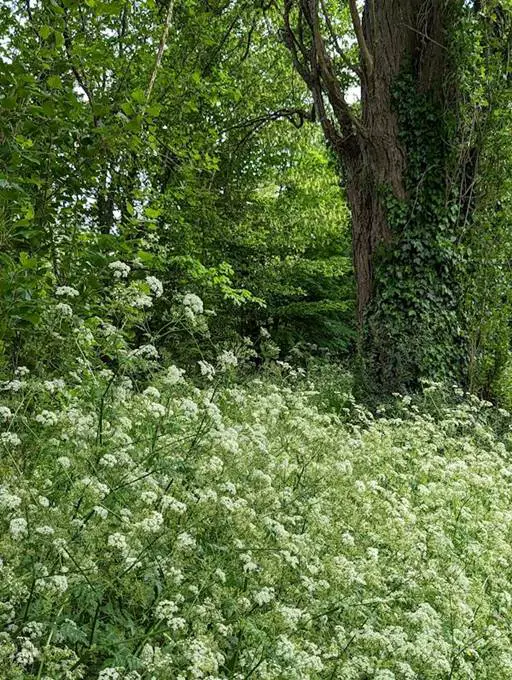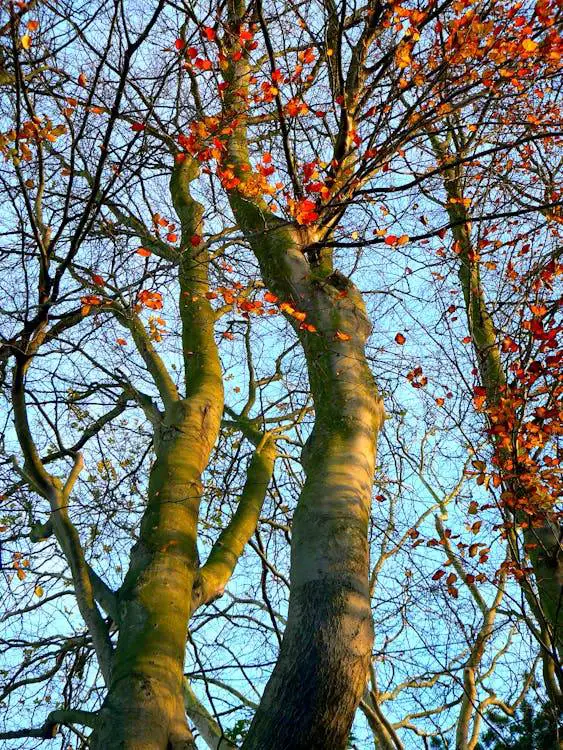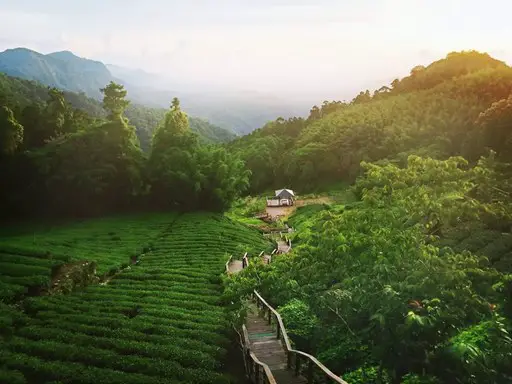
In this article, we will investigate the top 10 strange ways trees could astonish you, revealing insight into their uncommon variations, ways of behaving, and quirks. Plan to set out on an excursion into the universe of arboreal peculiarities.
Trees, the majestic monsters of the plant realm, never quit astounding us with their excellence and biological importance. While we frequently partner trees with their rich foliage and strong trunks, there are various particular and unforeseen qualities that make them considerably really captivating.
Strolling Trees: The Explorers of the Woodland

The remarkable Baobab trees of Madagascar have a particular capacity to “stroll” over the long run.
Because of their cumbersome trunks and shallow root foundations, these trees continuously shift their situation, giving the presence of development.
The strolling trees are a demonstration of nature’s inventiveness and versatile procedures.
Rainbow Eucalyptus: Nature’s Paint Range
The Rainbow Eucalyptus, local to Southeast Asia, features a dazzling showcase of varieties.
As the tree sheds its bark, energetic shades of green, blue, purple, orange, and maroon are uncovered.
This regular work of art makes the Rainbow Eucalyptus a really entrancing sight.
The Strangler Fig: Nature’s Hug
Strangler Figs are a gathering of trees that show a remarkable step by step process for surviving.
These trees start their life as epiphytes, sprouting high in the covering of host trees.
After some time, their foundations slip and fold over the host tree, in the end choking and supplanting it totally.
Talking Trees: The Vibrations of Life

Late investigations have uncovered that trees speak with one another through a huge underground organization of parasites known as mycorrhizal networks.
Trees trade data, supplements, and even admonitions about expected dangers through these contagious associations.
This unpredictable arrangement of correspondence features the interconnectedness and collaboration inside timberland biological systems.
Shaking Aspen: A Solitary Life form, Many Trees
Shaking Aspen trees might show up as isolated people, yet they are, truth be told, interconnected clones.
The trees share a typical root foundation known as a “clone province.”
This momentous transformation permits the trees to clone themselves and get by for millennia.
Tree of Life: The Most seasoned Living Tree
In the domain of old ponders, the Tree of Life remains as a genuine demonstration of the strength and life span of the normal world. Concealed in a remote corner of the planet, this wonderful tree is accepted to be the most seasoned living life form on The planet, challenging the progression of time and offering a brief look into the far off past.
The Tree of Life, experimentally known as Methuselah, is a bristlecone pine (Pinus longaeva) that lives in the White Piles of California, US. Assessed to be more than 4,800 years of age, this old tree has seen endless ages come and go, enduring through the ascent and fall of human advancements, and the moving scenes of the planet.
What makes the Tree of Life really peculiar is its capacity to get by in an unbelievably unforgiving climate. The tree flourishes in a locale portrayed by parched conditions, high elevations, and rocky territory. These circumstances, which would be aloof for most creatures, have really added to the tree’s life span. The dry environment has helped safeguard the tree’s wood, shielding it from rot and guaranteeing its endurance over centuries.
The Tree of Life has likewise adjusted to the super cold and solid breezes that move throughout the mountain range. Its curved and contorted branches, weathered by hundreds of years of openness, have turned into a demonstration of its versatility. These extraordinary qualities not just upgrade the tree’s capacity to endure unforgiving weather circumstances yet additionally add to its enrapturing and scary appearance.
Researchers have concentrated on the Tree of Life widely, looking to open the insider facts of its life span. They have found that the tree has a striking skill to recover and recuperate itself. At the point when a branch is harmed by lightning, wind, or other elements, the tree can compartmentalize the harmed region, forestalling the spread of disease and permitting sound tissue to develop. This recuperating system, joined with the tree’s sluggish development rate, has added to its unbelievable life expectancy.
The Tree of Life conveys with it a profound feeling of history and association with the past. As a living artifact, it has seen the ascent and fall of old civilizations, the introduction of groundbreaking thoughts, and the progression of time itself. Its presence fills in as a sign of the temporary idea of human life and the persevering through force of nature.
Furthermore, the Tree of Life has turned into a representative symbol, addressing flexibility, intelligence, and the interconnectedness of all life. Its old roots are a demonstration of the complicated trap of life on The planet and the significance of saving and safeguarding our normal legacy.
Notwithstanding, the Tree of Life’s definite area stays a strictly confidential mystery, as its safeguarding is of most extreme significance. The tree’s weakness to human obstruction and potential ecological harm require insurance from inquisitive people or those may not completely value its importance.
All in all, the Tree of Life remains as a really odd and dazzling regular miracle. Its status as the most established living tree on The planet and its capacity to flourish in outrageous circumstances make it an image of flexibility and perseverance. This old bristlecone pine fills in as a living association with our past, helping us to remember the momentary idea of human life and the getting through force of nature. The Tree of Life motivates us to esteem and safeguard the normal world, guaranteeing that people in the future can wonder about its magnificence and gain from its antiquated insight.
The Melodic Trees: Wind Playing Nature’s Instruments

The idea of melodic trees might seem like something out of a fantasy, however there are examples in nature where the breeze plays its own captivating orchestra through the branches and leaves of specific trees. This unconventional peculiarity, while uncommon, happens when explicit tree species produce pleasant sounds in light of the breeze going through their foliage. It is an odd and enamoring show of nature’s capacity to make music through startling means.
The melodic trees owe their extraordinary hear-able characteristics to a mix of variables, including the shape and game plan of their leaves, the adaptability of their branches, and the speed and heading of the breeze. At the point when these components adjust, the breeze going through the tree’s shelter makes vibrations that create particular melodic notes.
One illustration of such a tree is the aspen, known for shudder leaves ripple even in the smallest breeze. At the point when the breeze blows through an aspen woods, the aggregate stirring of the leaves makes a mitigating sound suggestive of delicate murmurs or a sensitive symphony. The aspen’s leaves have leveled petioles that permit them to vacillate all the more effectively, improving the melodic impact.
Another model is the eucalyptus tree, which has long and thin leaves that hang upward from the branches. At the point when the breeze blows through these leaves, they crash into one another, creating a progression of delicate snaps or applauding sounds. The musical idea of these sounds can bring out pictures of percussion instruments or even raindrops falling onto a surface.
In certain occurrences, the melodic trees can make amicable songs that reverberate with the general climate. The breeze going through a woods of bamboo, for example, can deliver an entrancing ensemble of empty, woodwind like tones. The empty culms of the bamboo vibrate because of the breeze, making a scope of melodic pitches that mix amicably together. This peculiarity has motivated craftsmen and performers, who have integrated the hints of bamboo forests into their arrangements.
While the melodic trees’ capacity to make sounds might appear to be otherworldly, it is a consequence of the multifaceted cooperation between nature’s components. The breeze goes about as the director, organizing the developments of the leaves and branches, while the trees themselves go about as the instruments, answering the breeze’s touch. It is a joint effort between the powers of nature that creates a fleeting ensemble.
The melodic trees spellbind our faculties as well as act as a wake up call of the interconnectedness and magnificence of the regular world. They advise us that even in the most unforeseen spots, nature can make amicable tunes that reverberate with our spirits. These trees welcome us to stop, tune in, and value the secret music that encompasses us.
All in all, the presence of melodic trees is a really unusual and charming peculiarity. These trees produce resonant sounds through the cooperation of wind with their leaves and branches, making a characteristic orchestra that enjoyments and captivates. Whether it’s the murmuring aspen, the applauding eucalyptus, or the agreeable bamboo forest, these melodic trees help us to remember the miracles of nature and its capacity to make excellence and music surprisingly. They welcome us to embrace the enchantment of the regular world and stand by listening to the spellbinding songs that can be tracked down even in the delicate stirring of leaves.
Oneself Pruning Palm: A Cunning Protection Instrument
Oneself pruning palm is an unconventional plant animal types that has a really unusual and interesting guard component. Found in specific tropical locales, this novel palm tree has fostered a smart variation to safeguard itself from expected dangers and guarantee its endurance in a serious climate. Through a cycle known as self-pruning, the palm tree sheds its own fronds for the purpose of safeguard and asset protection.
Not at all like most trees that hold their dead or biting the dust fronds, oneself pruning palm adopts a proactive strategy to keep up with its wellbeing and imperativeness. As the palm tree develops, the lower fronds continuously become concealed by the upper covering, prompting decreased photosynthetic limit and restricted admittance to fundamental assets like daylight and supplements. In light of this change, the palm tree starts a self-pruning process.
Oneself pruning system begins with the palm tree removing its own fronds close to the storage compartment. This cycle isn’t irregular yet rather an essential choice made by the tree. The palm tree distinguishes the more seasoned, less useful fronds and starts to debilitate their connection to the storage compartment. In the long run, these designated fronds become separated and tumble to the ground.
By shedding its lower fronds, oneself pruning palm tree accomplishes different advantages. Right off the bat, it dispenses with the weight of keeping up with non-utilitarian fronds, permitting the tree to divert its assets and energy towards the development of new fronds and the advancement of conceptive designs. This redistribution of assets guarantees ideal development and generation, expanding the palm tree’s possibilities of endurance and effective proliferation.
Besides, oneself pruning component fills in as a safeguard methodology. By shedding its lower fronds, the palm tree disposes of potential concealing spots for nuisances, bugs, and other creatures that could hurt the tree or consume its assets. Furthermore, the expulsion of old fronds diminishes the gamble of parasitic contaminations and other infections that might influence the general wellbeing of the palm tree. Oneself pruning process keeps up with the tree’s imperativeness and life span by limiting the effect of outer dangers.
Oneself pruning palm’s capacity to shed its own fronds at key stretches is a demonstration of its wonderful transformation and step by step process for surviving. This extraordinary safeguard component guarantees that the palm tree stays proficient in asset usage, constantly restoring itself and keeping up with ideal wellbeing.
Furthermore, oneself pruning palm’s capacity to shed fronds in a controlled way is likewise outwardly striking. It gives the tree a particular appearance, with a slim trunk delegated by a rich covering of dynamic green fronds. The course of self-pruning can be seen as a characteristic exhibition, with fronds bit by bit dropping to the ground, making a feeling of restoration and change.
All in all, oneself pruning palm addresses a really peculiar and surprising regular peculiarity. Through its special safeguard component, this palm tree sheds its own fronds to keep up with imperativeness, preserve assets, and shield itself from possible dangers. Oneself pruning process exhibits the palm tree’s capacity to adjust and streamline its development and endurance in a cutthroat climate. This strange variation fills in as a charming illustration of nature’s resourcefulness and the staggering systems utilized by plants to flourish and persevere.
The Bubbling Springs Trees: An Odd Thermoregulation
In the domain of unusual regular peculiarities, the bubbling springs trees stand apart as a really fascinating illustration of bizarre thermoregulation in the plant realm. Found in specific geothermal regions all over the planet, these particular trees have adjusted to make due in outrageous conditions where the ground temperature arrives at singing levels. Regardless of the threatening circumstances, these trees figure out how to flourish by using a novel thermoregulation system that permits them to endure the serious intensity.
The bubbling springs trees, once in a while alluded to as thermotolerant trees, have developed to adapt to the outrageous temperatures in their environmental elements. The ground underneath them is warmed by geothermal action, making the dirt arrive at temperatures that would be deadly for most plants. Nonetheless, these strong trees have fostered a momentous safeguard instrument.
The trees have particular underground roots that broaden profound into the ground, permitting them to take advantage of cooler water sources situated underneath the warmed surface. These roots draw up the cooler water and disperse it all through the tree, going about as a characteristic cooling framework. In a cunning variation, the trees likewise have a novel leaf structure that assists them with disseminating overabundance heat. Their leaves are in many cases restricted and lengthened, diminishing surface region and limiting openness to the sun’s beams. This forestalls exorbitant water misfortune through dissipation, empowering the trees to preserve dampness and keep up with hydration in the burning climate.
Another intriguing part of the bubbling springs trees is their capacity to control their own temperature. At times, the trees transmit a fume or steam from their trunks, making a practically strange scene. This arrival of steam is a consequence of the outrageous temperatures and the trees’ thermoregulation system. By delivering steam, the trees can chill themselves off, forestalling harm to their tissues and keeping up with their general wellbeing.
The bubbling springs trees are charming as well as act as a demonstration of the flexibility and versatility of nature. Through their extraordinary thermoregulation techniques, these trees have figured out how to cut out a specialty in a brutal and cold climate. They have developed to get by and flourish where numerous other plants would die.
These trees, with their uncommon capacity to endure outrageous intensity, offer a brief look into the surprising variety of life on our planet. They advise us that nature is loaded with shocks and that the limits of what we see as conceivable are continually being tested.
All in all, the bubbling springs trees address a really strange peculiarity in the normal world. These thermotolerant trees have created particular transformations to get by in conditions with searing ground temperatures. Their one of a kind root foundations, leaf designs, and thermoregulation components permit them to endure the outrageous intensity and flourish where not many other plants can. The bubbling springs trees act as a captivating illustration of nature’s capacity to adjust and make due even with testing conditions, leaving us in stunningness of the miracles that exist in our reality.
Tree Embracing: Woodland Washing for Wellbeing
The act of “tree embracing” or “woodland washing” is acquiring prominence as individuals find the medical advantages of being in closeness to trees.
Research proposes that investing energy among trees can diminish pressure, lower circulatory strain, and lift mind-set and invulnerable capability.
The therapeutic impacts of trees go past their esthetic allure, offering a characteristic solution for our prosperity.
End
The universe of trees is loaded up with amazing and peculiar miracles that never neglect to astound and motivate us. From strolling trees and talking timberlands to rainbow-shaded bark and old goliaths, trees continueto uncover their momentous variations and secret insider facts. Investigating these top 10 strange ways trees could shock you has not just extended how we might interpret their mind blowing variety yet in addition developed our appreciation for the normal world. Thus, next opportunity you go over a tree, pause for a minute to wonder about its eccentricities and recollect that there is in every case more going on behind the scenes in the enamoring domain of arboreal peculiarities.
